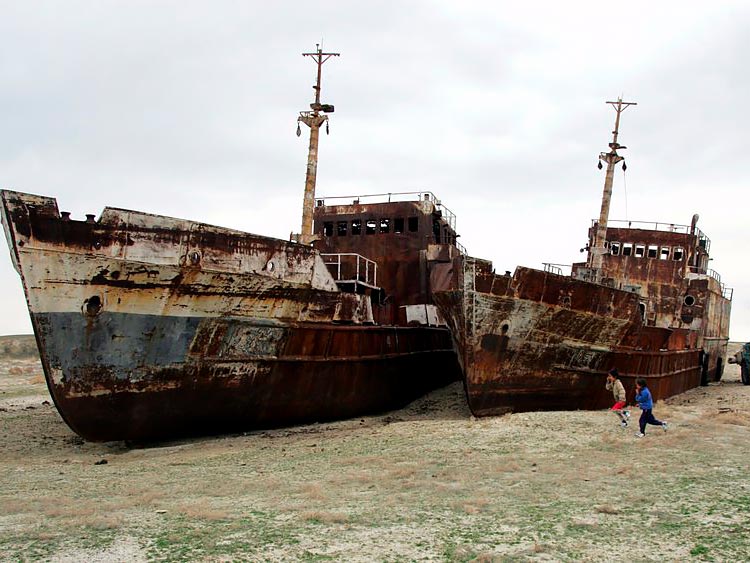The consequences of environmental disasters are horrifying, and my Muynak tour convinced me of that. The once flourishing port with a fish canning factory of state importance, as well as resorts and sanatoriums, has suffered a terrible tragedy. Today it is being revived, but the ships standing at the bottom of the dried-up sea will never be able to go sailing.
Both historians and archaeologists prove that the shallowing of the Aral Sea began several centuries ago. Not in the mid-1970s, as is commonly believed. Modern Muynak is a district center of the Karakalpak region, but it used to be a southern sea island with a fishing settlement. The water gradually receded and the island turned into a seashore.
Muynak was a fishing center in the XVII century, although it was considered a settlement. It received the status of a town only in 1963 when the construction of the largest fish cannery began. In 30 years the sea shoaled and moved 90 kilometers away from the town. Many residents left Muynak after the fish cannery stopped operating, and only a couple of years ago it was restored again. However, instead of canned fish, the factory produces beef stew.
Meanwhile, tours to Muynak are quite popular because tourists go there to see the graveyard of ships. They used to stand moored at the Navy Pier, but now their mission is to attract fans of apocalyptic landscapes. Ships in the middle of the desert attract tourists from all over the world as it’s both thrilling and unusual. I was attracted too.
Since getting to Muynak is possible only from Nukus, my friends and I were offered an Aral Sea tour. It involved leaving Tashkent by train straight to Nukus, then to Muynak by bus. The last route was to get to the remains of the sea by jeep. The jeep travels almost 100 km along the Aral Sea floor, which is extreme in a way. Many sandy places are covered with salt and the area looks like a snow-covered valley.
Muynak hotels are not very numerous, mostly tourists stay in private houses. There is also a yurt camp for authenticity seekers to experience the spirit of the region. We’re not big fans of extreme camping, so we stayed at a rather cozy Ratmina Muynak hostel. Well, let’s get back to our ships.
The ship graveyard is the main attraction of the town. Not a single Muynak tour would be complete without visiting this mystifying place, and that’s what people go there for. Looking at the string of rusty ships and small barges, you begin to understand the scale of the tragedy. The ships seem to be crying, calling people to be reasonable and to avoid ecological disasters.
One hour is enough to explore the ship graveyard and take photos against the background of ship hulks. Some of the ships are covered with graffiti, which looks very strange. That means there are unconventional painters in town who left their graffiti for a purpose. They might have honoured the dead ships in this way. Whatever the case, it’s nice to know that someone is sharing their love with the ships.
The sand is studded with sea shells, but as for shark teeth, we did not find them, despite the fact that travellers write about them on the Internet. Probably the tourists who were ahead of us took all the shark teeth, or you should wander around the desert for a long time to accidentally stumble upon them. Actually, the little sharks used to live in the Aral Sea indeed. Soon it was getting too hot to keep walking on the sea floor so we left.
In addition to seeing the ships, our Tashkent Muynak tour included an exploration of the town, and we went to the Museum of Local History of Karakalpakstan and the Aral Sea. There were hundreds of heart-stirring exhibits, which were divided into two parts: before and after the ecological catastrophe. First, we learned about the happy life of the people of this town prior to the drying up of the Aral Sea. Then the displays showed us all the consequences of its drying up.
Our excursion ended there, and we went to rest in the hostel, having a snack in a local teahouse. If you ask me whether it’s worth travelling more than a thousand kilometres to see the remains of ships in the desert, I will answer “Of course!”. Look, you will expand your horizons and experience reverent feelings unknown before.








